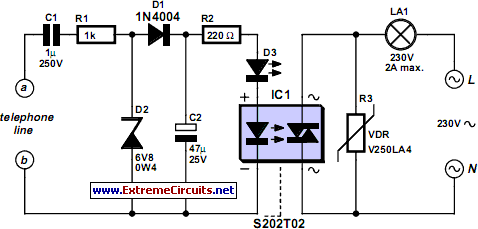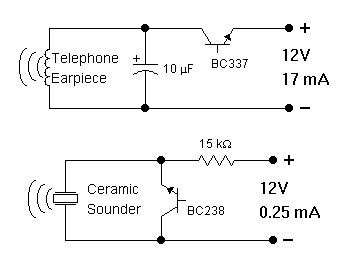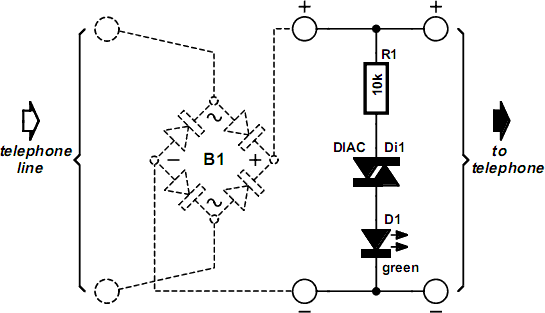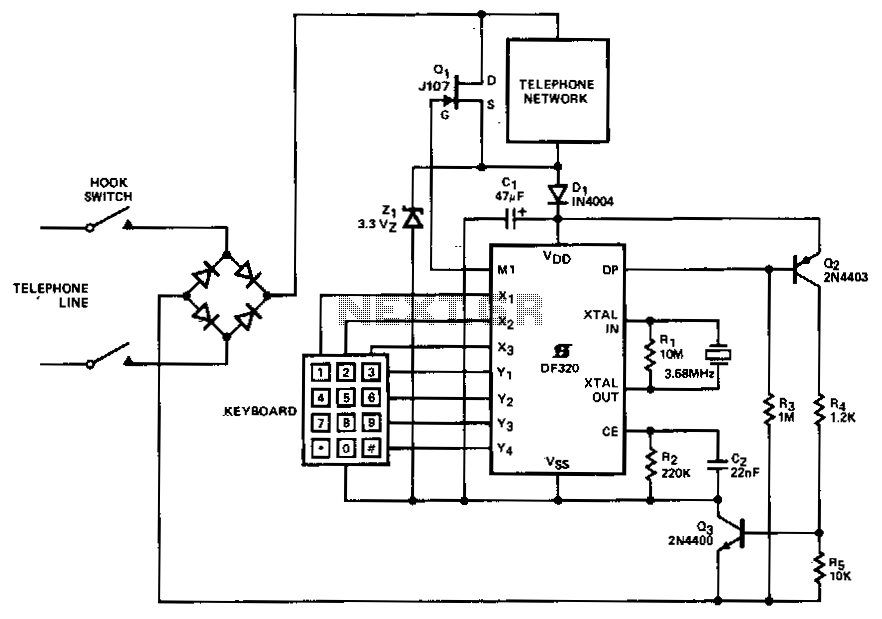
Telephone Ringer

A telephone ringer capable of making any mains-powered device operate from the ringer of a fixed line telephone. This device allows the control of a high-powered siren or horn to amplify the low-level sound of a telephone, making it audible in large spaces such as big houses or gardens. Alternatively, it can be used to light a lamp or indicator light, creating a silent ringer, which is beneficial when small children are napping. This simple and cost-effective project does not require a separate power supply, unlike similar products available in stores. It is crucial to understand that the ringer voltage on a fixed telephone line is relatively high, with variations depending on the country, as the EU Commission has not standardized it. The line carries direct current whether it is occupied or unoccupied. A few hundred milliamperes can be drawn from an unoccupied telephone line to make the PSTN exchange recognize the line as occupied. Capacitor C1 plays a dual role by insulating the project from the direct current on the line while allowing the ringer current to pass. The ringer current is rectified by diode D1 and limited by D2, providing approximately 6 V DC to the C2 terminals when a ringer signal is detected. This voltage activates LED D3, which serves as a visual indicator of proper operation, similar to the LED in IC1. IC1 is a high-power phototriac with zero crossing detection from the mains, enabling it to switch the controlled load without generating noise. This component resembles a TO220 package, is slightly larger, and has four pins, with clear markings on the diagram to prevent confusion. As this circuit is not widely available, it can be found on the Conrad Electronics website. For safe operation, the circuit includes a GeMOV on the mains side, known as a varistor, VDR, or SiOV, depending on the manufacturer. The load is limited to 2 A, based on the selected model for IC1, which is adequate for the intended application. It is essential to house the assembly in a fully insulated enclosure due to the connection of several components to the mains power supply for safety reasons.
This circuit functions by utilizing the ringing voltage from a telephone line to activate a load, such as a siren or lamp, without the need for an external power supply. The design incorporates several key components to ensure effective operation and safety. The ringer voltage, which can vary by region, is harnessed through the capacitor C1, allowing the alternating current (AC) ringer signal to pass while blocking direct current (DC) from affecting the circuit. Diode D1 converts the AC ringer signal into a pulsating DC voltage, which is then smoothed and regulated by D2, providing a stable 6 V DC output when the telephone rings.
The LED D3 serves as an operational indicator, lighting up to confirm that the circuit is functioning correctly. The inclusion of IC1, a phototriac, facilitates the switching of the load with minimal electrical noise, making it suitable for applications where sound disturbances must be minimized. The zero-cross detection feature allows the phototriac to turn on and off at the precise moment when the AC waveform crosses zero volts, further reducing electromagnetic interference.
Safety is a paramount consideration in this design. The varistor provides protection against voltage spikes that may occur in the mains supply, safeguarding the circuit components. The choice of a 2 A load limit ensures that the circuit can handle typical applications without risk of overheating or damage. The requirement for an insulated housing is critical, as it prevents accidental contact with live components, thereby ensuring user safety.
In summary, this telephone ringer circuit exemplifies a practical approach to amplifying telephone signals and offers additional functionality in a compact and cost-effective design, suitable for a variety of applications while adhering to safety standards.A telephone ringer capable of making any mains-powered device work from the ringer of your fixed line. With it, you will be able to control a high-powered siren or horn, as you like, in order to relay and amplify the low-level sound of your telephone (making it audible in a big house or in a large garden)!
Alternatively, you can make a lamp light (or an indicator light) and so create a silent ringer` (helpful when small children are napping). The other interesting part of this simple and inexpensive project is that it doesn`t require a power supply, contrary to similar items on sales in the shops. Before examining the drawing and understanding the principle involved, it is important to know that the ringer voltage on a fixed telephone line is pretty high.
Since Europe and the EU Commission have not yet interfered, the exact value of this voltage and its frequency varies according to the country, but that`s not important here. The line carries direct current whether unoccupied or occupied. Moreover, no more than a few hundred mAs needs to be stolen from an unoccupied telephone line to make the PSTN exchange believe the line is occupied.
Therefore, capacitor C1 has the dual role of insulating this project with respect to direct current present on the line while unoccupied, or while occupied, while also allowing the ringer current to pass. The latter is rectified by D1 and clipped by D2 which makes about 6 V DC available to the C2 terminals when a ringer signal is present.
This voltage lights LED D3 which only serves as a visual indicator of proper operation as does the LED contained in IC1. This is a high-power photo triac with zero crossing detection from the mains, which allows it to switch the load it controls without generating even the lowest level of noise.
This component, that we might just as well call a solid-state relay, was selected because it is comes in the form of a package similar to a TO220, a little bigger, and equipped with four pins. The pinout will not cause confusion because the symbols shown on our diagram are engraved or printed on the packaging.
Since this circuit is not yet very common, we need to mention that it`s available from the Conrad Electronics website ( For the purpose of safe operation, the circuit is protected by a GeMOV on the mains side, called Varistor, VDR or SiOV depending on the manufacturer. The model indicated here is generally available. The load will be limited to 2 A, considering the model selected for IC1, which is more than sufficient for the application planned here.
Finally, since a number of components in this circuit are connected directly to the mains power supply, the assembly should be placed in a completely insulated housing for obvious safety reasons. 🔗 External reference
This circuit functions by utilizing the ringing voltage from a telephone line to activate a load, such as a siren or lamp, without the need for an external power supply. The design incorporates several key components to ensure effective operation and safety. The ringer voltage, which can vary by region, is harnessed through the capacitor C1, allowing the alternating current (AC) ringer signal to pass while blocking direct current (DC) from affecting the circuit. Diode D1 converts the AC ringer signal into a pulsating DC voltage, which is then smoothed and regulated by D2, providing a stable 6 V DC output when the telephone rings.
The LED D3 serves as an operational indicator, lighting up to confirm that the circuit is functioning correctly. The inclusion of IC1, a phototriac, facilitates the switching of the load with minimal electrical noise, making it suitable for applications where sound disturbances must be minimized. The zero-cross detection feature allows the phototriac to turn on and off at the precise moment when the AC waveform crosses zero volts, further reducing electromagnetic interference.
Safety is a paramount consideration in this design. The varistor provides protection against voltage spikes that may occur in the mains supply, safeguarding the circuit components. The choice of a 2 A load limit ensures that the circuit can handle typical applications without risk of overheating or damage. The requirement for an insulated housing is critical, as it prevents accidental contact with live components, thereby ensuring user safety.
In summary, this telephone ringer circuit exemplifies a practical approach to amplifying telephone signals and offers additional functionality in a compact and cost-effective design, suitable for a variety of applications while adhering to safety standards.A telephone ringer capable of making any mains-powered device work from the ringer of your fixed line. With it, you will be able to control a high-powered siren or horn, as you like, in order to relay and amplify the low-level sound of your telephone (making it audible in a big house or in a large garden)!
Alternatively, you can make a lamp light (or an indicator light) and so create a silent ringer` (helpful when small children are napping). The other interesting part of this simple and inexpensive project is that it doesn`t require a power supply, contrary to similar items on sales in the shops. Before examining the drawing and understanding the principle involved, it is important to know that the ringer voltage on a fixed telephone line is pretty high.
Since Europe and the EU Commission have not yet interfered, the exact value of this voltage and its frequency varies according to the country, but that`s not important here. The line carries direct current whether unoccupied or occupied. Moreover, no more than a few hundred mAs needs to be stolen from an unoccupied telephone line to make the PSTN exchange believe the line is occupied.
Therefore, capacitor C1 has the dual role of insulating this project with respect to direct current present on the line while unoccupied, or while occupied, while also allowing the ringer current to pass. The latter is rectified by D1 and clipped by D2 which makes about 6 V DC available to the C2 terminals when a ringer signal is present.
This voltage lights LED D3 which only serves as a visual indicator of proper operation as does the LED contained in IC1. This is a high-power photo triac with zero crossing detection from the mains, which allows it to switch the load it controls without generating even the lowest level of noise.
This component, that we might just as well call a solid-state relay, was selected because it is comes in the form of a package similar to a TO220, a little bigger, and equipped with four pins. The pinout will not cause confusion because the symbols shown on our diagram are engraved or printed on the packaging.
Since this circuit is not yet very common, we need to mention that it`s available from the Conrad Electronics website ( For the purpose of safe operation, the circuit is protected by a GeMOV on the mains side, called Varistor, VDR or SiOV depending on the manufacturer. The model indicated here is generally available. The load will be limited to 2 A, considering the model selected for IC1, which is more than sufficient for the application planned here.
Finally, since a number of components in this circuit are connected directly to the mains power supply, the assembly should be placed in a completely insulated housing for obvious safety reasons. 🔗 External reference





